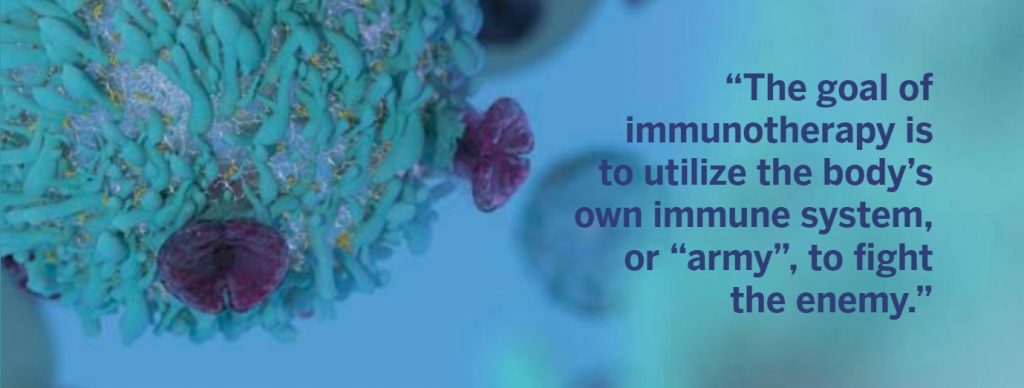Harnessing the Immune System to Treat Cancer Patients
By Rhonda Gentry, M.D.
Medical Director of Medical Oncology, CARTI
For many years, we have known that the immune system is the surveillance mechanism of the body. Its job is to police our tissues to quickly identify and attack any foreign molecules.
Despite a sophisticated immune system, cancer is notorious for evading it. This is due in part to the fact that cancer cells were previously normal body cells that acquired mutations, allowing for uncontrolled growth, which is notably different from normal cellular function. Because cancer cells are closely related to normal tissues, they are able to camouflage their molecular makeup, such that the immune system is unable to recognize them as the enemy. Since cancer is intuitive and adaptable, it often goes unrecognized for long periods of time, allowing the cells to hide and replicate, posing a more significant problem to the individual before the immune system even realizes its presence.

For more than one hundred years, we have utilized various treatment modalities to treat cancer, including surgery, radiation, and chemotherapy. It was known even in the 1800s that the immune system was also important for the treatment of cancer, but the intricacies of manipulating it often proved problematic. It has taken years to harness its potential so that effective treatments are tolerable to patients. We have come to an era when immune therapies are now finally available as a new treatment option for some patients. Thanks to advancements in modern medicine, cancer immunotherapy has become the fourth pillar of cancer treatment.
For much of the last century, scientists researched various aspects of the immune system and how to translate this into treatment. It was not until 1987 that the first immune checkpoint molecule was discovered, and its function remained unclear until the mid 1990s. Once it was realized to be a crucial step in immune recognition of cancer, clinical trials began. Despite decades of research, it was not until 2011 that the first immune checkpoint inhibitor was FDA approved for use in advanced melanoma. Since that time, multiple immune drugs have been approved, and are used in almost every cancer for select patients, some with dramatic and durable responses.
The goal of immunotherapy is to utilize the body’s own immune system, or “army”, to fight the enemy. When the immune system realizes how the cancer has been hiding, it is better able to identify the threat and destroy the cancer cells on its own. Ideally, it stops growth of cancer and prevents it from metastasizing to other parts of the body, while simultaneously recruiting more immune cells to join the fight. The immune system becomes the drug the cancer has been escaping. It can no longer disguise itself as normal once it has been exposed.
It is important to note that immunotherapy does not appear to work equally for all patients or all cancer types. Given this, we may combine immunotherapy with other traditional therapies to give our patients the greatest chance of remission.
So how does immunotherapy compare to more traditional infusion treatments, such as chemotherapy?
Protects Healthy Cells
Chemotherapy is known to attack cancer cells, but it can also cause some collateral damage to healthy cells, leading to many of the well-known side effects of chemotherapy. Immunotherapy, however, actually revs up the immune system in such a way that it allows it to identify and kill the cancer cells, while causing minimal effects on normal healthy tissues.
Gives Treatment Options to Those Who Would Otherwise Not be Candidates for Treatment
Since immunotherapy is generally less toxic than chemotherapy, some patient populations who were previously unable to tolerate chemotherapy are able to tolerate immunotherapy. These can include elderly patients and those with certain comorbidities, including cardiac issues or organ dysfunction. Additionally, for patients who have found chemotherapy is no longer effective in treating their particular cancer, immunotherapy may give them another option.
Reduces Side Effects
While immunotherapy may cause side effects, they are often drastically less than those that we typically see in patients who undergo chemotherapy. Patients often feel so well on treatment they worry it may be ineffective because they expect cancer care to come with a long list of negative side effects.
The side effects that are seen with immunotherapy occur when we rev up the immune system too much, and it begins to see healthy normal tissues as the enemy, and carries out a reaction against them. For example, if the lungs are inappropriately seen as foreign, it causes autoimmune pneumonitis, which can be severe if not recognized quickly and treated with steroids to calm the immune system. Similarly, the colon, thyroid, and adrenal glands can be common sites of autoimmune toxicity from immune therapies.
It is impossible to predict which patients will have side effects at the initiation of therapy, regardless of symptoms they may have had in the past. Subsequently, all patients are monitored closely and treated at the first sign of toxicity. Because patients with autoimmune problems such as psoriasis, lupus, or rheumatoid arthritis are already afflicted with an overactive immune system, these patients are often not able to routinely receive immune therapies for cancer treatment.
Easier Treatment Experience
Because of the reduced number of side effects, we do not have to routinely administer pre-medications when a patient receives an immunotherapy infusion. With fewer pre-treatment drugs, patients undergo shorter infusion times, making their entire experience easier.
Extends and Increases Quality of Life
Most importantly, we find that patients who respond well to immunotherapy are living longer, and experiencing a better quality of life.
While we are still in the relatively early stages of truly understanding immunotherapy as a cancer treatment, the changes that have occurred both on a molecular level and in the lives of our patients give us hope for a revolutionary shift in the way we can deliver front line cancer care. With additional research and refinement, the possibilities are endless for our ability to deliver personalized cancer care.






